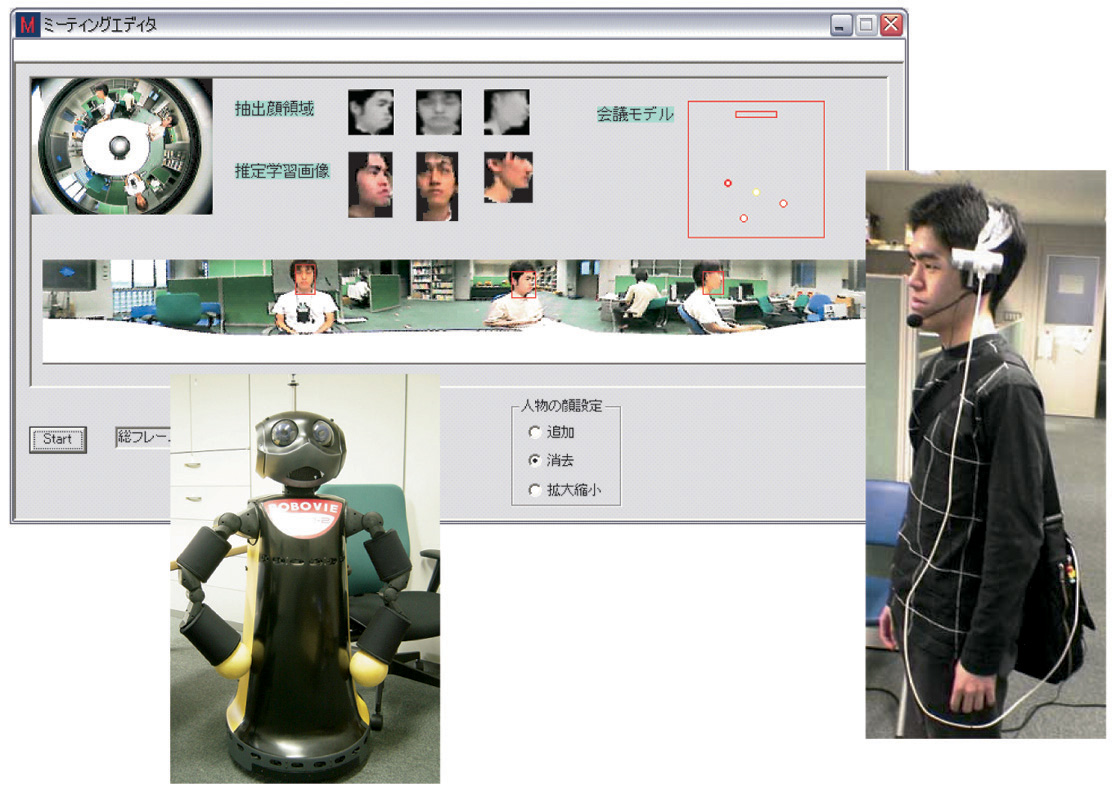Comprehensive List of Researchers "Information Knowledge"
Department of Systems and Social Informatics
- Name
- MASE, Kenji
- Group
- Knowledge Society and Information Systems Group
- Title
- Professor
- Degree
- Dr. of Engineering
- Research Field
- Communication support / Context processing and understanding / Ubiquitous interfaces

Current Research
Multimedia and Multi-modal Computer Mediated Communication
OUTLINEWe are promoting research on (1) computer mediated communication, (2) image processing and multimodal interfaces, and (3) wearable and ubiquitous computing for the future era of a computer-symbiotic society. Human-to-human communication is indispensable to any collaborative creative work or productive work. Communication plays an important role in our social activity, too. However, communication is not an easy task, especially in conveying our intentions clearly and in understanding the ideas of other people. Our aim in this research is to use computers as a medium for communication and a supportive tool for each step of communication. This involves recording experience and activity, summarizing it, presenting it in a comprehensive way, and thus reaching mutual understanding. The following three core themes are being tackled.
(1) Media Technology to record, to summarize and to share experiences
We have prototyped a meeting capturing system, a wearable video-blog tool, and a system for capturing sports plays and supporting team discussion. These systems support summarization of events, assist memory recall, and segment the events for annotation with appropriate tags.
(2) Media Processing Technology for context recognition and understanding
Context is a very important attribute of an experienced event. Since the same event can be interpreted differently if context differs, appropriate context information must be attached at the time of memory and be accessible during search steps. We are researching a multi-modal context analysis method for doctor-patient interview dialogs as well as multi-modal interaction pattern mining.
(3) Ubiquitous systems and interface design technology
Based on the systematic recording and analysis of users' contexts and interactions in real-world activities, we can design and provide useful and usable ubiquitous systems. Such interactions are stored and accumulated as an interaction corpus. The interaction corpus will become a knowledge-based social infrastructure.
Our group also belongs to the Information Architecture Group, in the Information Technology Center (ITC). ITC is an R&D and service center of the campus IT services. For example, it has launched a university portal site to serve as a one-stop login for many applications such as course management systems. Furthermore, a universal identification (ID) is being issued to all members of the university. I have served as a working group leader of the MEXT 21st COE program on Intelligent Media Integration (IMI) since 2002. I am also a project leader of a MEXT-funded project, cc-Society, that has been developing a Ubiquitous Leaning System, uClassroom, since 2004.
Future Work
My research themes are motivated by my background in motion-image processing for user interfaces, such as facial expression and gesture recognition. If we want to achieve better human-machine interface systems, we have to incorporate the capability of understanding user context in order to interpret gestures and events appropriately. Toward the future society, our IT systems will be developed symbiotically and include humanoid robots and wearable computers. These themes will establish future core technologies in practice and in theory.
URL:http://mase.itc.nagoya-u.ac.jp/~mase/

Figure : Meeting capture, intelligent robots, and wearable computers.
Career
- 1981 and 1992 : M. S. and Ph. D. degrees in Information Engineering from Nagoya University. 1981-1995 Nippon Telegraph and Telephone Corporation (NTT). 1988-1989 Visiting researcher at the Media Laboratory, MIT. 1995-2002 Group Leader at ATR (MIC, MIS). 2002-present Professor, Information Technology Center, Nagoya University.
- 1981 Nippon Telegraph and Telephone Corp. Yokosuka Research Laboratory
- 1988-1989, Visiting Researcher, MIT Media Laboratory, USA
- 1995 Department Head, Advanced Telecommunication Research Institute (ATR)
- 2002 Professor, Information Technology Center, Nagoya University
- 2009 Professor, Graduate School of Information Science, Nagoya University
Academic Societies
- IEEE (Senior Member)
- ACM
- IEICE(Fellow)
- IPSJ
- VRSJ
- IIEEJ
- Human Interface Society of Japan
- Instisute of Image Information and Television Enginners, Japan
Publications
- Recognition of facial expression from optical flow, IEICE Transactions, vol. E74, no. 10, 1991.
- How an Autonomous Information Retrieval Agent Affects Divergent Thinking by a Group, Vol. 14,No. 1,1999.(Best Paper Award, JSAI) In Japanese
- Yasuyuki Sumi and Kenji Mase: "Enhancing Daily Conversations", in book "Chance Discovery", edited by Y. Ohsawa and P. McBurney, Springer, pp.304-324, August, 2003.
- Human Reader : A Vision-based Man-machine Interface, in book "Computer Vision for Human-Machine Interaction", Cambridge University Press, 1998.
- Ubiquitous Experience Media, IEEE Multimedia, Oct-Dec, pp. 53-81, 2006.
- Informal Conversation Environment for Collaborative Concept Formation, in book "Community Computing : Towards Global Collaboration", John Wiley & Sons, pp. 165-205, 1998.
- Kenji Mase, Koji Imaeda,Nobuyuki Shiraki, Akihiro Watanabe, "Extraction of Pedestrian Regions Using Histogram and Locally Estimated Feature Distribution", in "In-Vehicle Corpus and Signal Processing for Driver Behavior", edited by Kazuya Takeda, John H.L. Hansen, Hakan Erdogan, Huseyin Abut, pp. 111-124, Springer. (2009.1)








